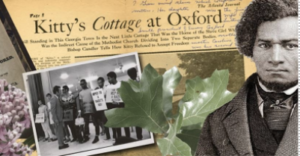A living installation for the symposium, “In the Wake of Slavery and Dispossession: Emory, Racism, and the Journey Towards Restorative Justice” 
Every step you take on Emory’s campus, you are on Muscogee (Creek) land.
The state of Georgia completed its effort to expel the Muscogee Nation as Emory University was being established in 1836. Our campus already has more than 150 native plants and trees, especially in the forested sections, a living reminder that Muscogee knowledge of plants are still here. The Educational Garden Project has been growing corn, tomatoes, beans, and other plants indigenous to the Americas.
This living installation highlights native plants of cultural and medicinal significance to Muscogee and other Indigenous People. These plants attract pollinators and support other non-native species. This is the first phase of a project that begins to restore the botanical landscape of the campus by prioritizing native plants.
Plants in this first phase of our restorative landscape include:
Lanceleaf Coreopsis Coreopsis lanceolata
Little Bluestem “Prairie Blues” Schizachyrium scoparium
Purple coneflower Echinacea purpurea
Swamp milkweed Asclepias incarnata
Swamp sunflower Helianthus angustifolium
White Yarrow Achillea millefolium
We look forward to their flowers blooming next year.
In the future, we hope to collaborate with partners from the Muscogee Nation to further develop this Native Plants Garden in the context of Mvskoke language, culture and botanical knowledge, historical trauma related to land dispossession, and Native food sovereignty.
Native American and Indigenous Studies Initiative, Emory Educational Garden Project, and Emory University Herbarium
